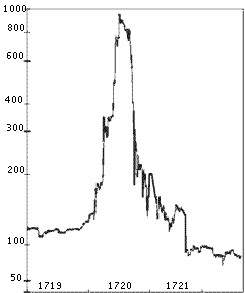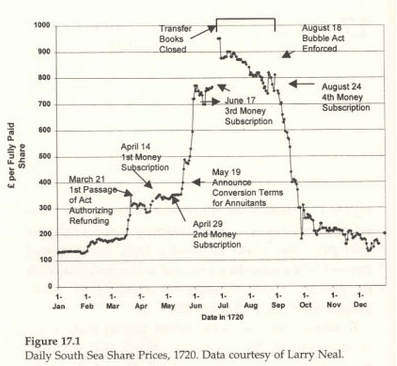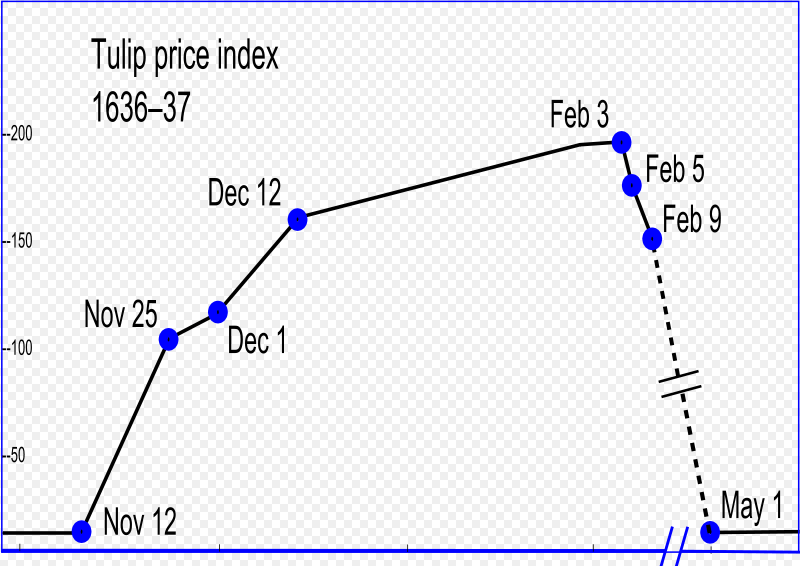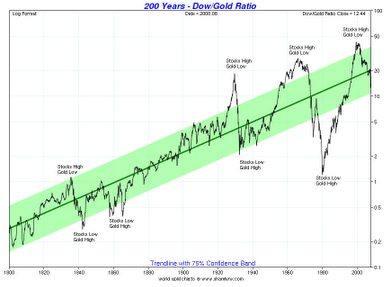I’m attending a convention from now through Wednesday, so expect a lot less activity here than has been the norm lately.
Regarding the markets, it is still my strong belief that we are in the process of making a top to last for many years, on a weekly as well as yearly and even decadal scale, since the prices of financial assets prices are still stretched far above levels that could be justified by expected returns. History is not kind to buyers of stock markets yielding 2% or real estate yielding a gross of 5%.
Society used to go through these episodes of financial mania briefly and locally. The South Seas bubble in England lasted a couple of years:
.
.
.
.
.
.
.
.
.
.
.
Close-up of 1720:
.
.
.
.
.
.
.
.
.
.
-
The earlier tulip affair in the Netherlands started in the fall and was over by spring:
-
In modern times, perhaps due to the ease of access that technology has brought to the markets and the emergence of a large middle class (though actually those explanations sound like feeble professorial BS), or possibly because of longer human lifespans (this I find more probable, as people need to collectively forget past experience in order to repeat it), we have the phenomenon of giant, recurring financial bubbles to accompany the credit/Kondratieff cycle.
One also has to note that the first such modern super-bubble began just a decade after the founding of a highly inflationary central bank, and that there has been no hard money nor hard-nosed policy since soon thereafter. After all, inflation is the expansion of money and credit, which always begets bubbles that are necessarily followed by crashes. These all-encompassing bubbles in everything are not healthy — they misdirect assets, squander wealth and shorten the time preference, which is no small thing. The young and already rotting cities of 20th-century-built North America are tawdry in comparison to those of Europe constructed in an age when real wealth was being accumulated at a blazing pace (yet inflation was non-existent or negative). People looked and planned further ahead, and built for yield and posterity, not to flip.
Here is a 200 year view of stocks priced in gold (DJIA for the last 100 years — approximation prior):
Marketoracle.co.uk
Isn’t that an interesting pattern? Looks like we’ve been in a huge megaphone since about the time of the Great War. The target for this leg is a Dow:Gold ratio of about 0.75. Dow 600, gold $800? Dow 11,000, gold $260 would have seemed pretty crazy in 1980, wouldn’t it?
- Tags: away, dow:gold ratio, south seas bubble, travel, tulip mania
3 Responses to “A long-term glance at modern bubbles.”
Leave a reply
Most Viewed Posts
- Add mortgages to the debt bubble (with junk bonds, munis, sovereign debt…) - 17,266 views
- Treasury-only money market funds - 14,817 views
- The next bubble: cash. - 14,217 views
- 90 day T-bill rate drops to 0.23%. What’s next, negative yields? - 11,786 views
- Inverse ETFs vs. LEAPS puts - 10,910 views
- Why bailouts will not stop the depression - 9,325 views
- About - 8,634 views
- Listen to the people who predicted this: No bailouts, no New Deal, no serfdom. - 8,001 views
- Commodities bubble bursting - 7,716 views
- On Black Thursday, 1929, the Dow closed down 2%. - 6,883 views
Recent Posts
- Nov 11, 2011 - Great little speech at EU: fire the bureaucrats & restore national sovereignty
- Nov 11, 2011 - Americans love war
- Nov 9, 2011 - Hussman: recession imminent
- Sep 20, 2011 - EBT rap video
- Sep 11, 2011 - Dick Cheney’s favorite holiday
- Aug 19, 2011 - A look at the real value of gold on an historical basis.
- Aug 18, 2011 - The material living standards of US rich vs poor, and the politics of envy.
- Aug 11, 2011 - In candid moment, Bernanke lets out the truth
- Aug 11, 2011 - If S&P’s downgrade actually matters, why are bonds up?
- Aug 1, 2011 - Farewell, Sheila Bair, and thank you (and FU Paulson, Bernanke & Geithner)
- Jul 25, 2011 - Europe’s dead stock markets
- Jul 25, 2011 - Rumors of dollar’s death greatly exaggerated
- Jul 4, 2011 - DSK all but cleared; no surprise here.
- Jun 24, 2011 - Jim Grant on Ben Bernanke
- Jun 7, 2011 - Kyle Bass and Hugh Hendry on shorting Japan
Recent Comments:
- A look at the real value of gold on an historical basis. - GolfBoy: Never mind - found it here:...
- A look at the real value of gold on an historical basis. - GolfBoy: Please, anyone - what is the historical...
- EBT rap video - Quentin Perrin: Hi, Sorry I write you via comments. But I could not find contact e-mail or feedback...
- EBT rap video - Linus Huber: SCARE 20.12.2012 (Stop Corruption and Repression Effective 20.12.2012) Banks were given...
- EBT rap video - steveo: Hawaii Trading and Breakpoint Trades (BPT) is providing a free newsletter on Commodities....
- At last, NYC rental and condo markets softening - Nicole Cervantes: Does any one know some one using web fame service...
- Toppy action in dollar index, another rally in stocks coming? - fireboy and watergirl: I like this site it’s a...
- A look at the real value of gold on an historical basis. - bobby: Hi Mike, I was wondering what you think of the...
- A look at the real value of gold on an historical basis. - Bjorn: Thanks Mike, that’s very helpful
- A look at the real value of gold on an historical basis. - Mike: BTW, if you are looking for high put prices, those...















Graphite
March 7th, 2010 at 4:19 pm
Surely you mean Dow 600, gold $800? Personally I like Dow 300, gold $400.
Personally I like Dow 300, gold $400.
Mike
March 7th, 2010 at 4:27 pm
Yes, of course (this was written under heavy jetlag) I meant Dow 600, gold 800, and actually my first inclination was to write 300/400, but it still seems too crazy even for me.
Graphite
March 7th, 2010 at 5:17 pm
BTW Charles MacKay’s Extraordinary Popular Delusions and the Madness of Crowds is available online for free here: http://www.archive.org/details/extraordinarypop014178mbp His histories of the Mississippi Scheme, South Sea Bubble, and Tulipmania are all very good reads. They tried all the exact same tricks to reinflate the bubbles back then. When they finally burst, the public’s desire for revenge was almost insatiable.